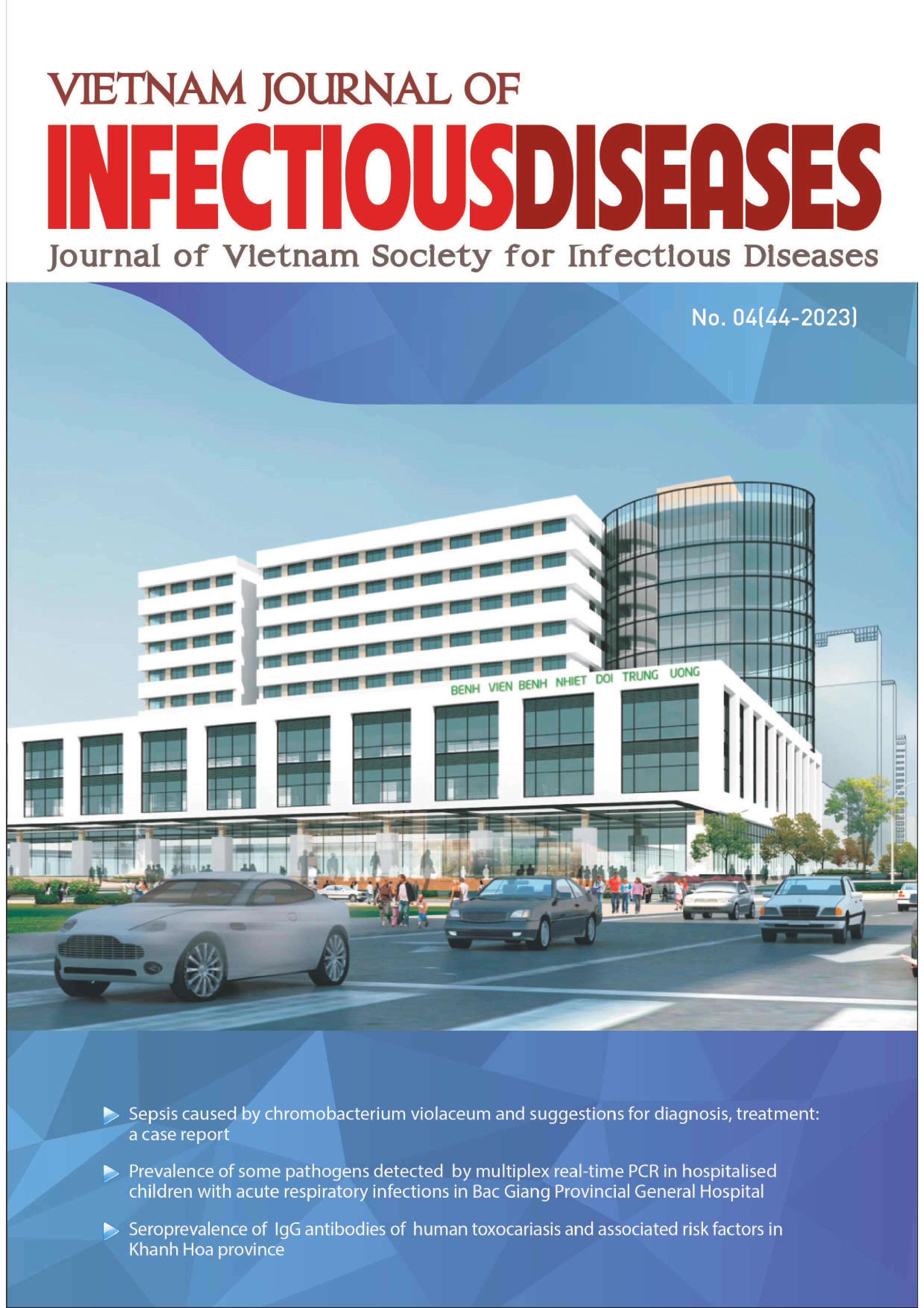PREVALENCE OF SOME PATHOGENS DETECTED BY MULTIPLEX REAL-TIME PCR IN HOSPITALISED CHILDREN WITH ACUTE RESPIRATORY INFECTIONS IN BAC GIANG PROVINCIAL GENERAL HOSPITAL
Nội dung chính của bài viết
Tóm tắt
Objectives: Investigate the infection rate of some microorganisms using multiplex real-time PCR techniques in inpatient children with acute respiratory infection (ARI) in Bac Giang Provincial General Hospital.
Subjects and methods: A retrospective cross-sectional descriptive study. There were 450 cases ARI children treated at the Pediatrics Department in Bac Giang Provincial General Hospital though medical records with multiplex real-time PCR results of nasopharyngeal swab testing using both RP1 and RP4 kits
were included in the study.
Results: Among 450 ARI children, the age group of under 60 months old accounted for the largest rate (81.6%). Influenza virus and RSV caused infection for infant and all ages group, focus on 2-60 months old group. The rate of pathogens detection using RP1 kit was 23.8% and the influenza infection rate was
13.6%, RSV was 10.2%. The rate of bacteria detected by RP4 kit was 40.0%. S. pneumonia, H. influenza infection were found across all age group, focus on children under 5 years old. The rate of S. pneumoniae infection was 24.4% and H. influenzae infection was 25.3%. M. pneumoniae infection was 2.4%, and such atypical pathogens mainly caused disease in the over 2 years old group. Some pathogens have low infection rate: B. pertusis (0.2%), L. pneumophila (0.2%), C. pneumoniae (0.2%). Combining RP1 and RP4 kits could enhance the detected rate of the ARI pathogens to 53.8%. 10.0% of co-infections were detected. Influenza infection rate was highest in spring (10.5%), decreased in summer and autumn, and gradually increased in winter (5.6%). RSV infection rate was highest winter (5.6%). S. pneumoniae and H. influenzae infections were distributed equally over the year but the peaks were found in November 2020 (7.1% - 6.0% respectively) and January 2021 (5.8% - 6.9% respectively). The highest rate of M. pneumoniae infection was in April 2021 (1.8%).
Conclusions: Kit RP1 could detect 23.8% respiratory pathogens , of which 13.6% were influenza; 10.2% RSV. There were 40.0% positive for at least one pathogen in the RP4 kit, including 24.4% S.pneumoniae, 25.3% H. influenzae, 2.4% M. pneumoniae, 0.2% B. pertusis, 0.2% L. pneumophila, 0.2% C.
pneumoniae. Combining RP1 and RP4 kit could enhance the positive rate to 53.8% including 13.8% were infected with 1 kind of virus, 30.0% were infected with 1 kind of bacteria and 10.0% were co-infection.The co-infection patterns still remain unclear and could be a result of random combination. Influenza,
RSV and M. pneumoniae infections were significant affected by seasoning, while S. pneumoniae and H.influenzae infections were sporadic all over the time
Chi tiết bài viết
Từ khóa
RP1, RP4, ARI, Multiplex real-time PCR
Tài liệu tham khảo
2. WHO Guideline (2014). Infection prevent and control of epidemic and pandemic prone acute respiratory infection in healthcare. ISBN 978 92 4 150713 4.
3. Lamrani Hanchi et al (2021). Epidemiology of Respiratory Pathogens in Children with Severe Acute Respiratory Infection and Impact of the Multiplex PCR Film Array Respiratory Panel: A
2-Year Study. International Journal of Microbiology (2021) 1-9, https://www.hindawi.com/journals/ijmicro/2021/2276261/.
4. Verhoeven (2019). Immunometabolism and innate immunity in the context of immunological maturation and respiratory pathogens in young children. Journal of Leukocyte Biology (2019), Vol 106, Issue 2, 301-308.
5. Phùng Thị Bích Thủy và CS. Ứng dụng kỹ thuật PCR đa mồi trong chẩn đoán các căn nguyên gây nhiễm trùng đường hô hấp ở trẻ em tại Bệnh viện Nhi Trung ương. Tạp chí Nhi khoa 2016.
6. Weidmann MD et al (2023). Assessing respiratory viral exclusion and affinity interactions through co-infection incidence in a pediatric population during the 2022 resurgence of influenza and RSV. Front. Cell. Infect. Microbiol. 13:1208235. doi: 10.3389/fcimb.2023.1208235.
7. https://www.ecdc.europa.eu/sites/default/files/documents/influenza-characterisation-reportmay-2020.pdf. Influenza virus characterisation.
8. https://www.ecdc.europa.eu/sites/default/files/documents/influenza-characterisation-reportJune-2020.pdf. Influenza virus characterisation.
9. https://www.ecdc.europa.eu/sites/default/files/documents/influenza-characterisationreport-November-2020.pdf. Influenza virus characterisation.
10.https://www.ecdc.europa.eu/sites/default/ files/documents/influenza-characterisation-reportfebruary-2020.pdf. Influenza virus characterization.
11. Bui Huu Manh et al (2009). Modelling the progression of pandemic influenza A (H1N1) in Vietnam and the opportunities for reassortment with other influenza viruses. BMC Medicine 2009, 7:43 doi:10.1186/1741-7015-7-43.
12.Preeta K. Kutty et al (2019). Mycoplasma pneumoniae Among Children Hospitalized With Community-acquired Pneumonia. Clin Infect Dis. 2019 January 01; 68(1): 5–12. doi:10.1093/cid/ciy419.
13.Chien-Yu Lin et al (2020). Increased Detection of Viruses in Children with Respiratory Tract Infection Using PCR. Int. J. Environ. Res. Public Health 2020, 17, 564; doi:10.3390/
ijerph17020564.
14.Rudzani Muloiwa et al (2020). The burden of laboratory-confirmed pertussis in low- and middle-income countries since the inception of the Expanded Programme on Immunisation (EPI) in 1974: a systematic review and meta-analysis. BMC Medicine, (2020) 18:233.
15.Richard D. Andersen et al (1981). Infections with Legionella pneumophila in Children. The Journal Of Infectious Diseases • Vol. 143, No.3. March 1981.
16.Gregory P. DeMuri et al (2018). Dynamics of Bacterial Colonization With Streptococcus pneumoniae, Haemophilus influenzae, and Moraxella catarrhalis During Symptomatic
and Asymptomatic Viral Upper Respiratory Tract Infection. Clinical Infectious Diseases 2018;66(7):1045-53.


